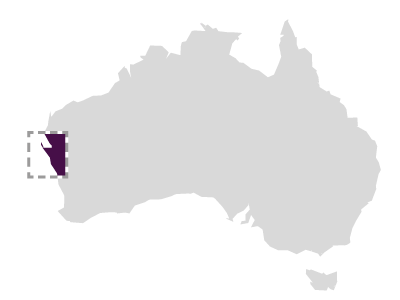Ocean Queen (1842/09/13)
Abrolhos

Ocean Queen (1831–1842)
Where built: Whitby
Year built: 1831
Registered: London
Rig type: Barque
Hull: Wood
Tonnage: 286
Port from: Launceston
Port to: Bali
Date lost: 13 September 1842
Location: Half Moon Reef, Pelsaert Group, Houtman Abrolhos
Chart number: Aus 81 & Aus 751
GPS position: Lat: 28º 56.5' S Long: 113º 51.7' E This is not a GPS position
Finder: Max Cramer. 1969
Protection: The site is protected under the Historic Shipwrecks Act 1976
Significance criteria: 1
THE VESSEL
The barque Ocean Queen was built at Whitby by J. Langborne and Company in 1831, and owned by Robert Brooks. On 10 July 1840 it had been badly damaged when it struck at Flinders Island Bass Strait, while on a voyage from London to Launceston in Tasmania. The vessel was subsequently repaired. The Ocean Queen was bound from Launceston to Bali in ballast and had aboard a chest of specie.
THE LOSS
The Ocean Queen under the command of Captain Harrington, with fourteen crew, struck Half Moon Reef while sailing at 6 knots early in the morning of 13 September 1842. The vessel was thrown on its ‘beam ends’ and bilged. The crew used the ship’s boats to get ashore on an island (described as a large island) where they stayed for two days. Captain Harrington initially claimed that he had buried the specie on the island during this time. The men then embarked in the Ocean Queen’s boats in an attempt to row to Fremantle. The wind and current were against them, and when about 125 km north of Fremantle, between Wedge Island and present day Lancelin, they abandoned the boats and walked the remaining distance, arriving in Fremantle on 9 October. An exhausted crewman, who had been left behind at the Moore River, arrived in Fremantle on 11 October, having been rescued by a party led by Mr von Bibra and James Milne.
INITIAL SALVAGE
The wreck of the Ocean Queen was sold for £25 (or possibly guineas) to Captain Daniel Scott, the Harbour-Master at Fremantle, in October 1842. He commenced salvage almost immediately by sending his boat, crewed by the mate and crew of the Ocean Queen, to the wreck. En route this boat stopped at the site where the survivors had come ashore, retrieved the abandoned boats from the Ocean Queen and the personal effects left buried by the sailors. They searched diligently but apparently unsuccessfully for the specie, which Captain Harrington now claimed to have buried there. A little over a week later Scott and Harrington left in the chartered cutter Venus for the wreck to supervise salvage efforts. On arrival Scott found that his boat, which had sailed from Fremantle over a week before the Venus, had arrived only two days before it.
He salvaged much of the moveable gear including the mail, stores, anchors, cables and part of the rigging from the barque, as well as the boats that had been abandoned on the coast.
The Perth Gazette and the Inquirer both queried how the wrecking had occurred, as Wickham and Stokes on board HMS Beagle had recently accurately surveyed the Houtman Abrolhos. Further, the wrecking took place not during a storm but in favourable winds. Captain Scott besides being harbour-master was also Lloyd’s agent, and it was in this latter position that he had sold the wreck to himself. At the time there was some public disquiet and scepticism over this sale and the failure to recover the specie.
SITE LOCATION
The wreck of the Ocean Queen lies on Half Moon Reef between the Zeewijk and Windsor wreck sites.
SITE DESCRIPTION
A trail of ballast stones lies from about 20 m inshore of the wave line across the reef top to the lagoon.
EXCAVATION AND ARTEFACTS
A museum inspection team in 1979 recovered a cannon ball, copper sheathing tacks, spikes, a copper ring bolt and some glass and pottery sherds. The small artefacts were recovered from crevices and holes in the reef, and the cannon ball from the reef top.
STATEMENT OF SIGNIFICANCE
HISTORIC (1)
There remain unanswered questions regarding the fate of the specie carried on board the Ocean Queen. Note however that ‘specie’ is a very vague term and it may be that it was not of great value.
Some criticism has been made of the fact that Captain Scott in his capacity as Lloyd’s agent sold the wreck to himself as a private citizen. It cannot be denied that he was an interested party, however Western Australia had such a small population at that time that many people held multiple positions. Money in the colony was in such short supply that even the £25 paid for the wreck, combined with its isolation on the Houtman Abrolhos, would not have been an attractive proposition for many businessmen.
REFERENCES
Bateson, C., 1982, Australian shipwrecks: including vessels wrecked en route to or from Australia, and some strandings, volume one: 1622–1850. A.H. & A.W. Reed Pty Ltd, Sydney.
Henderson, G.,1980, Unfinished voyages: Western Australian shipwrecks 1622–1850. University of Western Australia Press, Nedlands.
McCarthy, M., 1981, Colonial wrecks in the Abrolhos Islands. Report—Department of Maritime Archaeology, Western Australian Museum, No. 27.
Uren, M., 1980 (1940), Sailormen’s ghosts. Angus & Robertson Publishers, Sydney.
Ship Built
Owner Robert Brooks
Master Captain Harrington (Wilson CS)
Builder Brooks
Country Built UK
Port Built Whitby
Port Registered London
When Built 1831
Ship Lost
Grouped Region Mid-West
Crew 17
When Lost 1842/09/13
Where Lost Abrolhos
Latitude -28.969736
Longitude 113.8969
Port From Lanceston
Port To Bali
Cargo Ballast, mail and specie
Ship Details
Engine N
TONA 268.00
Museum Reference
Unique Number 1577
Sunk Code Wrecked and sunk
File Number 2009/0171/SG _MA-353/77
Chart Number AUS 332
Protected Protected Federal
Found Y
Inspected Y
Date Inspected 1979/11
Confidential NO